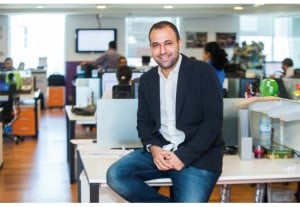Ali Nehme believes that marketers need to mirror agility and experiences consumers expect today.
Purchase and consumption shifts are paving the way for dramatic new habits, ones that will continue to evolve until they become dominant. These new habits are not being translated into a shift in spend and investment. The endless struggle to protect the traditional share is a losing one; everybody is basically fighting the wrong battle. Today, top advertisers, across verticals, are exploring e-commerce, even though most of them don’t know quite what to expect.
We’re an industry of $4bn spend at best, with an average of $14 in media spend per person. Compare that to the US with their average of $589 per person, and we’re 36x behind. This applies as well to most European countries – with an average spend exceeding $250. What does this mean? We have a long way to go and to mature as a market; whether it’s an education issue or a pricing readjustment, the industry needs to be reimagined in order to grow the overall pie.
To develop within this new era, we need to change the way this industry is positioned. Putting the analogue thinking behind us, let’s start practicing what we preach. Throwing words like measurable and trackable around whenever we mention digital does not change the fact that we’re still far from proving our worth. Here’s a start:
Digital currency and ethics
Today we’re at a stage where every ad server allows us to measure what is basic to the industry, yet untold to many advertisers. If you’re a publisher and still debating moving to a viewable impression at some point in time then you’re going to be in a tough position soon. At least let’s start by agreeing that we’re not doing any better than analogue. If half of the inventory sold is never seen, let’s not poke holes in the traditional measurement methods. If that entails inflating the media costs then let it be, at least we’re being transparent and doing the comparison rightfully. Would this be another advantage for the big guys? The answer is yes; we already started optimising accordingly since the technology allows it, mainly on Audience on Demand, our trading desk. Not only that, technology allows us to bypass most of the pushbacks from frequency capping to a narrower geo-targeting and much more. This does not mean that publishers have to suffer and have fewer impressions to sell, but it rather pushes the smaller players to invest more in their ad experience and find the balance between moving the ad unit higher up without affecting the user experience.
Organising data around people
Harnessing and analysing big data is increasingly becoming more difficult due to the lack of insights about the end goal; being pragmatic and going back to basics is what we need today. Instead of trying to measure every medium in silo, we (at SMG) try to understand how to organise data around people because we believe experiences matters. We use data to transform behaviour through uplifting, meaningful human experiences. This means that our approach, structure and even technology need to understand and talk to a connected consumer in real-time and multi-screen world. Big Internet giants like Facebook and Google have – or have the potential – to crack the model with a universal identity. Publicis Groupe took a huge step this year with the acquisition of RUN to bring its clients closer to a connected solution. Having said that, cross-device limitations still exist. Data owners like telcos can play a big role in bringing the pieces together. With more education around the stored personal data, both the owners and the users will have confidence in storing and mining such information. In turn, this will improve the quality of cross-screens tracking and attribution.
Rapid learning models
We need such models in the way we mine valuable insights in shorter duration, the way we apply that to the challenges and finally in how we track and measure it all. You see, there is no Holy Grail in digital; with such a fast-moving environment, it is key to start identifying small opportunities for quick feedback. Planning will remain key to avoid wastage but the cycle has become shorter with much faster iterations. We need to think from the inside out; if every advertiser and agency goal is to get closer to the digital world, breaking the silos especially within the digital teams has to happen fast. We need to mirror the agility and experiences the consumer expects today. The big players can be a great gateway to reshape ourselves, and can be a great ally to build partnerships and push the barriers.
As we move towards this new era, our infamous media plans will blur with less “buckets” as no one cares if the brand content is being consumed on a laptop, phone or TV. The digital era has changed the way we look at things, let’s stop narrowing the way we position ourselves. Instead, let’s consider it as a fresh start to build a much bigger and better industry.
(Ali Nehme is managing director of digital at SMG MENA)










